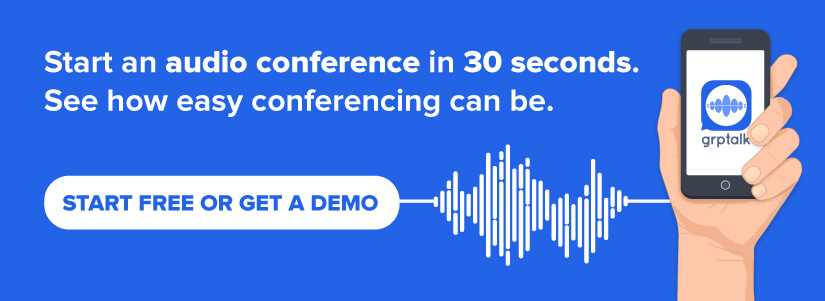Here’s one for you: What do you call a conference of the butchers?
A meat-ing.
But, that is not the type of meeting we will discuss today.
Audio conferencing, or simply conference calling, is the process of using a communication system either over telephone lines or the internet to conduct an audio-only meeting. A typical audio conference hosts as few as three participants or as many as thousands upon thousands.
A typical audio conference does not need a lot of effort or equipment. All you need is a stable phone or internet connection, a speaker to hear from, and a microphone to talk into.
In recent times, the demand for audio conferencing platforms has really increased. Many companies worldwide are using this technology not only to connect and collaborate with their clients but also with their distributed or remote employees.
Amid widespread demand, audio conference technology providers are racing to enhance the business professional’s user experience and add value to audio meetings. To achieve that, most of them now offer various online collaboration capabilities, such as team messaging, call recording, and screen sharing, as a bonus.
At this point, we’d be remiss if we didn’t distinguish an audio conference from a traditional phone call.
There’s just one critical difference. Audio conferences enable participants to connect or dial into a central system instead of each person having to dial one another, as would be the case with phone calls.
That “central system” is what the industry generally refers to as an audio conference/conferencing bridge, a conference call bridge, or, simply, a conference bridge.
What is an audio conferencing bridge or conference bridge?

A conference bridge is a hardware or technology that connects multiple participants in seamless communication within a virtual meeting room. It typically supports many simultaneous conference calls without necessarily compromising audio quality.
Hands down the most reliable audio conference app.
Get started with FREE call minutes.
No credit card required.
Discover exactly how to make an audio conference call on Android and iPhone
Besides call stability and clarity, most conference bridging services also provide voice encryption technology to maintain privacy. That’s highly desirable if you are keen on hosting secure communication and ensuring confidentiality.
The history and early days of conferencing as we know it
Conference calls have come a long way since their inception.
If we were to flip through the history pages, we’d find that the first instance of anything close to a conference call as we know it occurred in Bulgaria in 1945.
Assen Jordanoff designed a wireless device called, Jordanphone, which could carry speech to many recipients via a standard phone and loudspeaker.
Then, in 1956, Bell Labs started working on telephone conferencing, a concept nearly identical to the kind of audio conferencing that we know today.
By 1960, AT&T picked up the mantle from Bell Labs and dove deep into the teleconferencing world.
The company’s innovative approach succeeded and gave birth to the first-ever conference that supported audio and video via phone lines in the form of the device called Picturephone Mod II.
With it, users could talk on the phone and see each other on a tiny screen that changed display every few seconds.
The device, however, couldn’t make its way into mass production and the corporate world because it was bulky and expensive. Despite its failure to launch, the technology broke new ground and got people talking about the possibilities of remote conferencing.
Now that we know a little more about audio conferencing, let’s explore its various executions.
Types of audio conferencing

Broadly speaking, there are two types of audio conferencing:
- Inbound (also called one-to-one or point-to-point conferencing)
- Outbound (also called multi-point conferencing)
We’ll expound on each below.
Inbound audio conferencing
An inbound audio conferencing system is also known as a one-to-one or point-to-point system.
With it, two or more people can connect and communicate instantly, even from different geographical locations.
To begin such an audio conference, the host has to create and share the link and/or the passcode with participants. Then all the participants have to do is click on the link and enter the passcode to join in. The passcode secures the meeting and bars unwanted guests.
Outbound audio conferencing
An outbound audio conferencing system is also known as a multi-point system. It’s useful for larger conferences, i.e. conference calls with more than three participants.
Creating and distributing the passcode or meeting link with three or fewer people is easy. However, simple passcode distribution doesn’t quite cut for larger audio conferences.
So, it is better to use outbound audio conferencing technology in such situations.
To set up an outbound conference, the first step will be for you to add in your participants’ contacts. Once done, the system automatically sends the meeting link and passcode to every participant.
Now imagine a situation where you have set a conference call with hundreds or even thousands of participants.
Manually adding each participant like you would in an inbound audio conference would be a nightmare.
That’s why outbound systems are a godsend. They make organising meetings a lot simpler.
Once you set up the meeting, all the participants have to do is check their calendars and use the link or passcode to join in.
Now that we have a clearer understanding of inbound versus outbound, let’s look at the pros of audio conferencing.
Advantages of audio conferencing
The following are the most obvious advantages of audio conferencing compared to other communication channels. The comparisons here are mostly tied to web conferencing and video conferencing, in particular.
1. It is cost-efficient

Audio conferencing is one of the most cost-effective communication and collaboration mediums for business today.
It saves you money on two fronts.
Firstly, it does not require heavy or expensive equipment.
Analyse it side-by-side with video conferencing, and you’ll soon find that the latter (even if “heavy” equipment isn’t needed) is more expensive. It cannot do without the use of a laptop or a desktop, a stable internet connection, and a webcam.
On the other hand, audio conferencing will only require a mobile phone with a working sim card. And who doesn’t have that nowadays?
Secondly, audio conference calls can save your business a lot of money when it comes to travel costs.
That was one of the lessons businesses worldwide had to learn from the recent pandemic-induced travel restrictions.
Audio conferences can very easily replace expensive business trips and seminars. Thanks to the money saved by such conference calls, businesses can therefore redirect resources toward more pressing goals.
2. It is flexible and easy to use

Audio conferencing is a favourably flexible and easy-to-use communication solution.
It enables teams to conduct all types of audio meetings, such as training sessions, board meetings, sales meetings, or even performance assessment panels.
Since audio conference platforms have basic requirements for their participants, they’re also more reliable. You are less likely to run into a technical issue when hosting an audio meeting than when hosting a video meeting or webinar, for example.
Audio calling setups are also simpler to figure out and use, making them ideal for pretty much anyone. They are also ideal for most types of collaborations.
They allow users to conduct meetings at any time and anywhere – whether in a professional work environment or not.
That’s right. You could host or listen to the most stellar presentations while lounging in your beloved pyjamas. Or even while stuck in a remote village during fieldwork or an out-of-town trip.
3. It is private and secure

We have all heard the now infamous Zoom data breach story. A loophole in the platform allowed hackers to steal Zoom users’ data. This incident happened when the platform had just gained popularity among remote teams globally in the wake of the COVID-19 pandemic.
That incident sparked privacy concerns for frequent users of video and web conferencing platforms.
On the other hand, audio conferencing has remained a lot more secure. Any privacy concerns are easily tackled with bit-level encryption.
With such technology, audio meetings are virtually impossible to breach. That makes them a lot more reliable for sensitive communication and data sharing.
Now that you know the advantages of audio conferencing in general, it’s time to decide on features and platforms.
But remember that your decision needs to be based on your needs.
So let’s first look at the must-have features.
Features & capabilities that the best audio conferencing tools have

You shouldn’t compromise on the following features and capabilities in your search for a worthwhile audio conference call tool.
1. Call scheduling
One of the primary motivations for choosing audio conferencing tools should be that they usually come armed with call scheduling capabilities.
Scheduling calls eliminates any possible time that could be wasted manually punching in participant contacts before the meeting.
All you would have to do is schedule the call on the date and time it is supposed to happen and wait for the audio conferencing system to do the rest of the work for you.
2. Call recording
This feature is helpful for participants who cannot attend the audio conference as it happens. It allows them to go in and listen to the audio recording of the meeting at their convenience.
Recordings are also valuable for skill enhancement programs or knowledge transfer sessions. They can be useful in educating people about topics already covered at previous conferences.
3. PINs
PINs secure audio conferences from any unauthorised attendance.
Guarding access to the meetings via PINs saves time and adds an extra layer of security and privacy to your audio conference setup.
4. International calling
You need a method of setting up international calls if your company has a cross-border presence and overseas clients.
International calling facilities will allow you to host unlimited calls with employees, shareholders, clients, or any other company stakeholders.
So, now that you are clear about what to look for in an audio conference hosting platform let’s consider when and why it would be necessary to use one.
When to choose or use audio conferencing over other mediums

When deciding whether or not to use an audio conferencing platform, ask yourself these three critical questions:
- Do you really need visuals?
- Do participants have the necessary setups or connections?
- Do you need a professional setting?
Let’s dive a little deeper into these questions.
Do you really need visuals?
If your answer is no, then audio conferencing might be what you’re looking for.
Often, video conferencing can drain resources and time. Video meeting setups are more complex, and participants are more likely to encounter technical issues while on the call.
So, the obvious question you need to ask yourself is whether or not you’ll need to present or share a screen on call. If the conference can do without the visuals, then go with audio conferencing without hesitation.
Do participants have the necessary setups or connections?
As mentioned above, video conferencing takes longer and requires more devices to set up.
You should opt for audio conferencing if you are dealing with a situation where devices are unavailable. Likewise, opt for it in a case where figuring out setups or connections will delay the entire communication or meeting process.
Do you need a professional setting?
One of the perks of remote communication is you don’t always have to be in a professional setting, and even if you are, the other parties in question are not concerned about that fact.
So if you find yourself in a situation where voice-based communication is sufficient for collaboration, stick to audio conference calls. Do this when meetings need to happen regardless of participant locations, dress codes, or background surroundings.
You should also read:
- Should You Choose a Free Conference Call App Over a Paid One?
- 10 Best Conference Call Apps For Business
- Mobile Conference Calls Guide For Dummies/Beginners
- Best Apps For Audio Conferences For Large Groups
An introduction to audio conferencing with grptalk
Now that we’ve discussed audio conferences in great detail, it’s time to introduce you to grptalk.
grptalk is an easy-to-use audio conferencing app that lets you connect with anywhere from 3 to more than 10,000 participants on the same call in less than 30 seconds.

Numerous industries use and have used the tool in various ways, either to stay in touch or increase sales.
Let’s explore them below.
How companies are leveraging audio conferencing with grptalk
Here’s how companies are using grptalk to enhance their collaboration and revenues.
1. As an additional sales channel
Automobile giants like Mahindra use grptalk to sell and market their tractors directly to Indian farmers.
They also use the platform to inform their customers about various new promotions and offers as they become available.
2. As a customer support channel
While UPL and Corteva also use grptalk to sell and market their products, their territory managers use the platform for customer issue enquiries.
Furthermore, they provide customers with suggestions for their issues and educate them on how to use their products.
3. As an internal communications channel
L&T and Mahindra Insurance Brokers Ltd. use grptalk for internal communications, including review meetings, regular meetings, or quick catch-up calls.
Your organisation may want to maximise sales, improve customer-side communication, and facilitate internal communication too. And you could easily do that with grptalk audio conference calls.
Book a demo today and start hosting seamless and scalable audio meetings immediately.
Reach out to book a demo, ask conferencing-related questions or get help from our team 24/7.
Get to know more about grptalk and how it can benefit your business. We offer complete audio conferencing solutions for your communication needs.










0 Comments